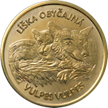
 coinage 153SKDistance 84 kmHubertíkova Zverofarma - Liška obecná
coinage 153SKDistance 84 kmHubertíkova Zverofarma - Liška obecná
The Tatranský Zveropark is part of the four-star Hotel Hubert complex in Gerlachov, located beneath the peaks of the High Tatras. In the animal park, you can see various animals such as goats, ponies, Highland cattle, a peacock, an alpaca, a swan, an emu, and a Vietnamese pig. You can not only see them but also feed them.